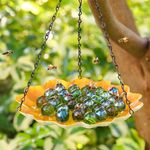
In her article “Spring Planting Ideas,” Michelle Gervais beautifully illustrates the magical time that is the start of spring: “Our winter-weary spirits lift as hints of green begin to appear. We notice even the smallest patches of snowdrops and crocuses as we drive by at 55 miles per hour. The first daffodil sighting is a thrill, and tulips are almost too colorful to bear. The pale chartreuse haze in the trees seems to change to lush, vibrant green overnight, and every new sprout brings delight. It’s the start of another exciting season, and the potential and possibilities for our gardens seem boundless.”
While spring is often a flurry of planting, planning, and performing the many garden chores in between, it’s always a treat to have some plants that will kick off the season with color while others are still waking up and waiting for warmer weather to show off their best. This spring planting plan was crafted by regional expert Hunter Ten Broeck and would be a spectacular addition to any Southwest garden.
1. Arizona bluestar

Name: Amsonia grandiflora
Zones: 6–10
Size: 1½ to 3 feet tall and wide
Conditions: Full sun to partial shade; dry, well-drained soil
Native range: Southern Arizona; northern Sonora, Mexico
Arizona bluestar is a deeply rooted, long-lived, very drought-tolerant mounding perennial. Its beautiful, pale blue star-shaped flowers are a delight in spring. Like other bluestars, this species has fine-textured dark green foliage that turns a vibrant yellow in fall. A low-care plant, it only needs to be cut back once a year in late winter. Arizona bluestar can be slow growing, but it’s well worth the wait. In spring it looks good next to yellow-flowered plants such as Kannah Creek® sulphur buckwheat (Eriogonum umbellatum var. aureum ‘Psdowns’, Zones 3–8), and its fading foliage looks great next to the seed heads of liatris (Liatris spp. and cvs., Zones 3–8) in fall.
2. ‘Major Wheeler’ coral honeysuckle

Name: Lonicera sempervirens ‘Major Wheeler’
Zones: 4–8
Size: 6 to 8 feet tall and 3 to 6 feet wide
Conditions: Full sun to partial shade; well-drained soil
Native range: Eastern North America
‘Major Wheeler’ coral honeysuckle makes a welcome addition to the garden if you want a relatively compact vine that blooms profusely from spring through summer. The stunning, deep orange-red, trumpet-shaped flowers are a huge draw for hummingbirds. This low-maintenance vine requires little to no pruning and is a great choice for trellises, arbors, and fences. In warmer or protected microclimates, the foliage can stay evergreen, but usually it’s deciduous in most of its range. If you want the vine to produce berries after flowering, you will need a different variety of coral honeysuckle nearby to cross-pollinate.
3. ‘Mersea Yellow’ pineleaf penstemon

Name: Penstemon pinifolius ‘Mersea Yellow’
Zones: 4–9
Size: 8 to 12 inches tall and 12 to 18 inches wide
Conditions: Full sun; well-drained soil
Native range: Southeastern Arizona, western New Mexico
This penstemon is a showy compact perennial whose blooms appear in early June and continue through summer. The flush of yellow tubular flowers is attractive to a variety of hummingbirds, butterflies, and bees. ‘Mersea Yellow’ is also rabbit and deer resistant. This plant can grow well in sandy or gritty soil but cannot tolerate wet conditions. The foliage is evergreen in warmer zones and semi-evergreen in the coldest areas of its zonal range. Shear off the spent flowers after blooming to reveal a dense, tidy green mound that will persist for the remainder of the year. ‘Mersea Yellow’ pairs well with spring-blooming purple or blue flowers.
4. ‘Sea Foam’ artemisia

Name: Artemisia versicolor ‘Sea Foam’
Zones: 4–9
Size: 8 to 12 inches tall and 18 to 36 inches wide
Conditions: Full sun; dry, well-drained soil
Native range: Mediterranean region
An attractive compact ground cover for borders or rock gardens, ‘Sea Foam’ artemisia was brought into cultivation by garden designer Lauren Springer. Its silver foliage provides a wonderful accent for perennials and ornamental grasses with green or blue foliage and really makes them pop. The intricate texture of this cultivar’s semi-evergreen foliage creates year-round interest. Tall, thin, white to yellow flower spikes appear in summer and should be deadheaded by late winter. These blooms are unremarkable; it’s the foliage of the plant that really shines. Try not to overwater this beauty or it will lose its charming tight form. Artemisias have a lovely scent and are deer and rabbit resistant.
Hunter Ten Broeck owns and operates WaterWise Landscapes in Albuquerque, New Mexico, along with his wife, Barb.
View the full collection of regional planting plans and see the rest of issue 216.
Fine Gardening Recommended Products

Razor-Back Potato/Refuse Hook
Fine Gardening receives a commission for items purchased through links on this site, including Amazon Associates and other affiliate advertising programs.

Bee Watering Station with Vivid Flower Design
Fine Gardening receives a commission for items purchased through links on this site, including Amazon Associates and other affiliate advertising programs.

ARS Telescoping Long Reach Pruner
Fine Gardening receives a commission for items purchased through links on this site, including Amazon Associates and other affiliate advertising programs.



















Comments
Log in or create an account to post a comment.
Sign up Log in